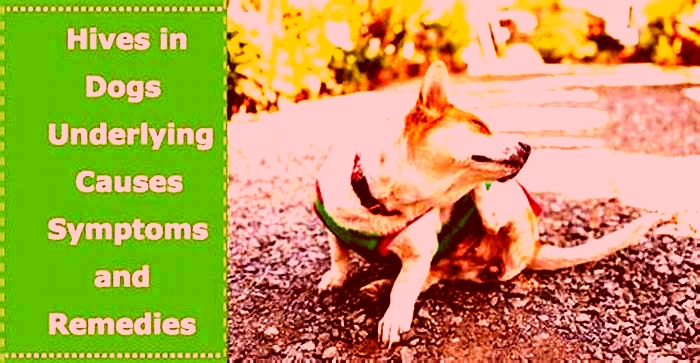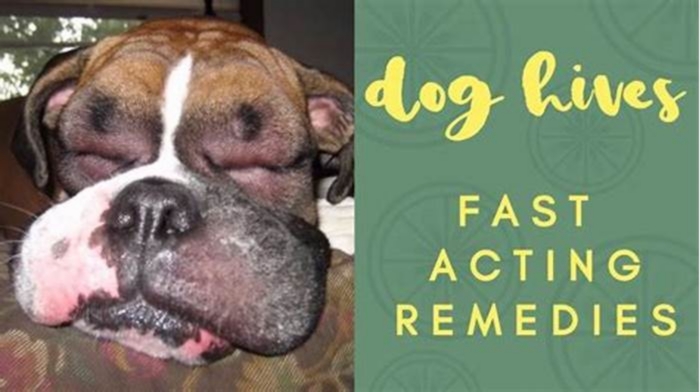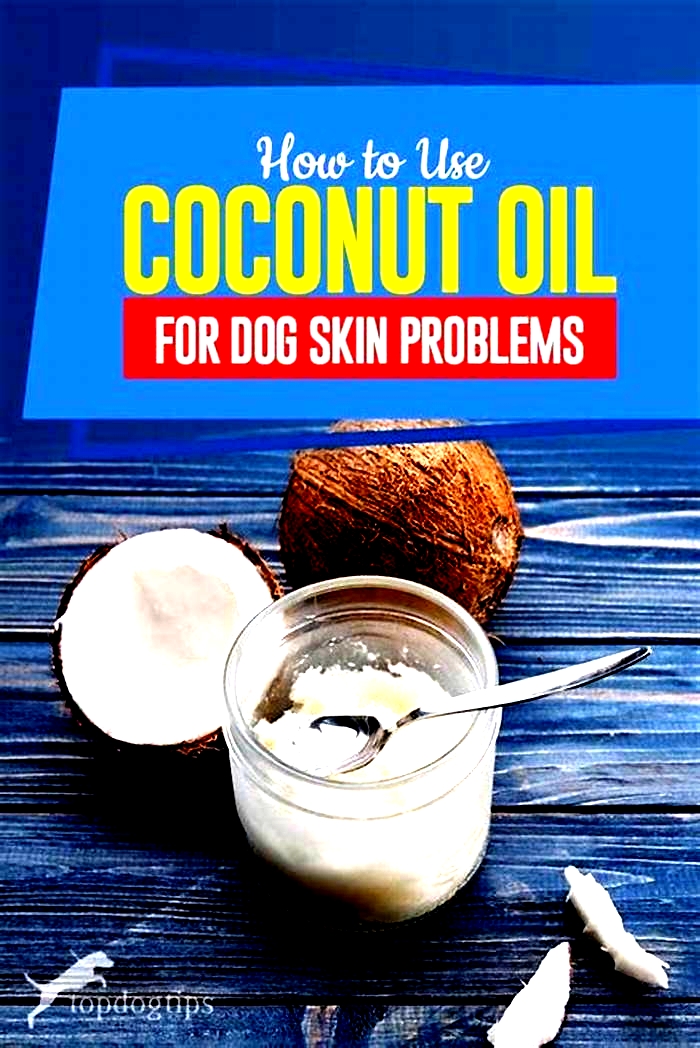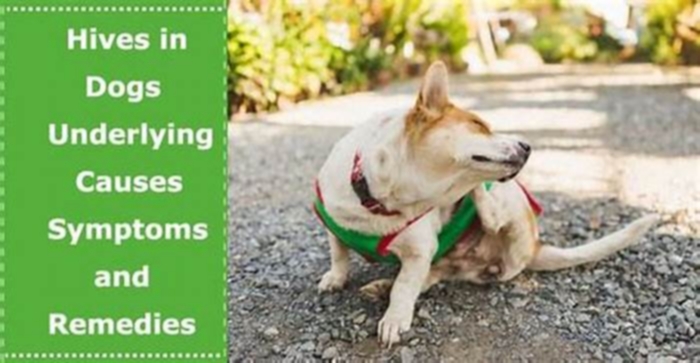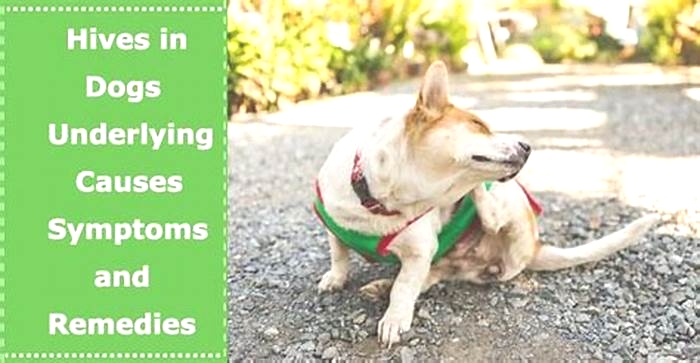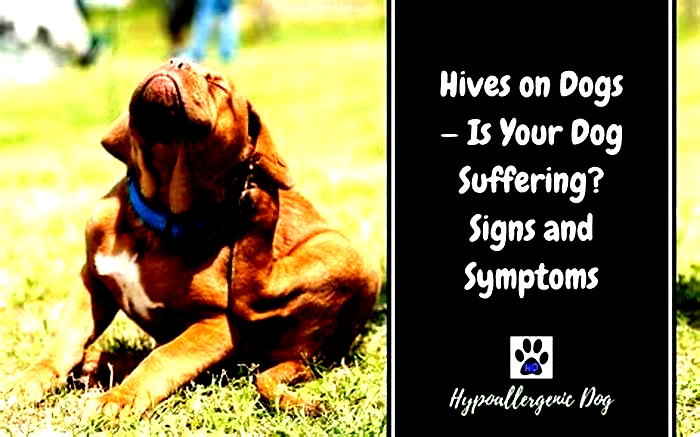How can I help my dog with hives
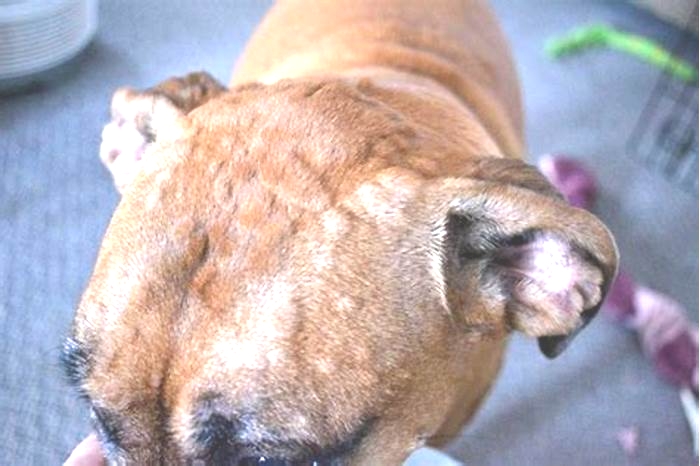
Dog Hives
What Are Dog Hives?
Hives (also referred to as urticaria) are areas of the skin that appear reddened and raised. Just as with humans, hives can be very itchy for your dog. Theyre a sign that an allergy is causing the immune system to overreact.
Hives can appear very quicklyand disappear just as quickly. The raised red area of the skin is referred to as a wheal, and it can appear anywhere from a few minutes to hours after exposure to an allergen. Wheals can appear anywhere on your dogs body, but theyre usually found on the head, neck, back, stomach, and legs.
In mild cases, the hives will generally disappear within 12-48 hours after contact with the allergen. However, because of the risk that the reaction can worsen to dangerous swelling of your dogs airways or a serious allergic reaction called anaphylaxis, you should seek out treatment any time you see hives on your dog. This is especially true for hives that occur on the face or around the throat, which can lead to dangerous swelling and possible blockage of the airways.
Symptoms of Dog Hives
Red raised areas of skin called wheals, which can occur anywhere (including mucous membranes) but are most commonly seen on the head, neck, back, abdomen, and legs
Intense itching
Excessive drooling if the mouth is swollen
Swelling (angioedema), which is particularly concerning when it involves the face and respiratory system and can have severe and life-threatening consequences
Causes of Dog Hives
The allergen that causes the hives may be environmental, chemical, or dietary. Any allergen your dog is sensitive can also lead to hives. Common causes include:
Insects bites, chemical contact, and medications are the most common.
How Vets Diagnose Hives
Your vet will closely examine your dog to locate the distinctive wheals associated with hives. Wheals typically have hair on them, and may appear in clusters. Beyond the physical examination, other parts of the diagnosis include:
Any history you are able to provide; be as thorough as you can in describing allergens your dog might have come into contact with and when and where you first saw the hives
Your dogs response to treatment
Treatment for Dog Hives
Dogs with hives usually respond quickly to treatment, which may include:
At-home treatments may include:
Cold compresses over the hives or swollen areas to give relief from itching
Antihistamines, but only under the supervision of your vet
Management of Dog Hives
Work with your vet to determine the cause of the hives, using both your dogs health history and history of exposure to allergens. Depending on the cause and the frequency, your vet may recommend:
Allergy testing to confirm environmental allergens
Immunotherapy treatment to desensitize your dog to specific allergens
A food trial to find ingredients that cause a reaction and develop specific dietary recommendations
Dog Hives FAQs
Are dog hives an emergency?
Yes. Hives indicate an allergic reaction within the body. Although the hives themselves are mostly just uncomfortable, they could lead to very dangerous complications, including anaphylaxis and death. Its best to treat even mild cases of hives.
What can I give my dog for hives?
It is important to speak to your veterinarian before giving your dog any medication. The vet may recommend certain medications to give your dog now or to have ready for future episodes.
How long do hives last?
Hives can disappear within a few hours or last up to 48 hours.
Can anxiety cause hives in dogs?
Theres a small chance that psychological stress can cause dog hives, but generally, anxiety merely worsens hives that are already present.
Should I take my dog to the vet for hives?
Yes, hives indicate a larger issuean allergic reactionand require treatment to make your dog comfortable and keep the reaction from progressing.
What do hives look like on a dog?
Hives are red, often swollen areas of skin that may be very itchy. They can be anywhere on the body, but youll often spot them on your dogs head, neck, back, stomach, or legs.
What foods cause hives in dogs?
There is no one food that generally causes hives in dogs. However, if your dog is allergic to a particular food or ingredient, that can cause hives for your individual dog.
Dog Hives (Urticaria | welts): Causes, Diagnosis & Treatment
What Are Dog Hives (Urticaria)?
Hives, otherwise known as urticaria by medical professionals, are one abnormality you may see. They occur when your dog is allergic to something, such as an insect, medication, or food. Recognizing hives in dogs and understanding the cause is essential to relieving your dogs discomfort and preventing dog hives in the future.
What do dog hives look like?
- Dog hives look like raised bumps on the skin, usually about the size of a nickel.
- Hives are usually red in color; however, you may not notice redness if they are on a very furry part of your dog. In this case, your pets hives may only look like fur-covered bumps. Sometimes, its difficult to see the raised bumps, and you may only feel them when petting your dog.
- Dog hives can appear anywhere on the body, including the face, tongue, neck, legs, chest, abdomen, or back. They can affect just one area of the body or the entire body.
- Dog hives are very itchy. This may be the first thing you notice before seeing or feeling hives on your dogs skin. Your dog will likely be trying to scratch, lick, or bite the areas affected as it will be itchy.
- Hives usually happen very fast within minutes after exposure to whatever caused them.
- You may notice excessive drooling and a swollen/puffy face if the hives affect your dogs throat or mouth.
What causes hives on a dog?
Dog hives are almost always related to exposure to an allergen. Once exposed to an allergen, mast cells in your dogs body release a substance called histamine. Histamine causes blood vessels to dilate, which leads to raised welts on your dogs skin.
The most common allergens causing dog hives include:
- Insect bite or sting, or ingesting an insect (photo recommendation: dog playing with bee)
- Vaccinations
- Acute allergic reactions to medications (chemotherapy, vitamin K, antibiotics)
- Food allergies
- Environmental allergies (grasses, trees, mold, dust mites, etc.)
- Contact allergens such as shampoos, insecticides, cleaning products
- Ingesting or skin exposure to toxic plants
Much less common causes of hives in dogs include prolonged exposure to extreme temperatures (hot or cold), strenuous exercise, parasites, or significant psychological stress.
Insect bites/stings, food, and medications are the most common causes of hives in dogs.
How are dog hives diagnosed?
As a pet parent, it can be worrisome to see these skin rashes, but luckily, for your vet to diagnose your dogs hives. Your vet will use a combination of your history and their physical examination findings.
Its essential to think about anything new your dog may have been exposed to. Did you see them playing with a bee? Were they recently vaccinated? Did they start a new medication or a new food? During the physical exam, your veterinarian will look at your dogs skin to evaluate hives and where the hives are located.
If your veterinarian is having trouble diagnosing your dogs hives or the reason for their hives, they may perform additional diagnostics, such as blood work, skin cytology, skin scrapings, or fecal analysis.
How to treat & get rid of dog hives?
Treatment for hives in dogs can be simple or more extensive, depending on the cause, severity, and duration of the allergic reaction.
To get your dog quick relief from the swelling and itchiness related to hives, your veterinarian will usually administer an injection of diphenhydramine (an antihistamine) and a corticosteroid. Once your dog is feeling better and discharged from the hospital, your veterinarian may also recommend that you continue giving your dog Benadryl two to three times a day at home for a couple of days.
To prevent hives from reoccurring, you need to understand what caused them in the first place so that you can avoid the allergen in the future. If there is no apparent cause for your dogs hives (such as insect bite, medication, or vaccinations), it may be more challenging to understand how to prevent hives in the future. Environmental and dietary allergies are two possible causes of hives that may require further diagnostics and treatment.
Environmental allergies
If your dog has recurrent hives or has other signs of allergies, your veterinarian may recommend testing for environmental allergies with serum allergy testing or intradermal allergy testing. With these results, your veterinarian can create a plan to desensitize your dog to these allergies with allergen-specific immunotherapy.
If you determine that you cannot eliminate the allergens in your dogs environment or pursue allergen-specific immunotherapy treatment, your veterinarian may recommend:
- Giving your dog daily antihistamines (such as Benadryl, zyrtec, or hydroxyzine)
- Giving your dog other prescription-strength allergy medications such as apoquel or cytopoint
- Starting daily skin health supplements, such as omega-three fatty acids.
- Frequently bathing your dog with medicated high-quality shampoo
Food allergies
Allergies that stem from food can also cause recurrent episodes of hives in dogs. The most common cause of allergies in dogs include chicken, beef, dairy, and egg 2. Recurrent episodes of hives can also be related to dietary allergies. To diagnose a food allergy, your veterinarian may recommend a diet trial for 6-8 weeks with a prescription food or an over-the-counter diet with a different protein source, like fish or venison. If your dog responds positively to a food trial, you can continue the special diet long term.
Are dog hives dangerous?
Dog hives are rarely life-threatening. However, there are a few less common situations where hives can affect your dogs breathing and become dangerous.
- Hives in the face, neck, or throat can cause severe swelling that impacts breathing, which can become life-threatening.
- The presence of hives anywhere may indicate your dog is having or about to have an anaphylactic reaction, which causes constriction of airways and difficulty breathing. 3 Besides hives, other signs of anaphylaxis include vomiting, diarrhea, facial swelling, drooling, blue gum color, and collapse.
If you notice that your dog has hives, pay particular attention to how they are breathing and for any other concerning changes in their behavior. If you are concerned your dog may be having severe allergic reactions, take them to the emergency room immediately to rule out a medical emergency.
At-home remedies for dog hives
If possible, take your dog to the veterinarian if you notice they have hives, especially if this is a first-time problem. If your dog chronically or intermittently has hives and the issue has previously been discussed with a veterinarian, some at-home remedies may help relieve the allergic reaction.
- If the hives are not affecting your dogs face, neck, throat, or ability to swallow, you can administer Benadryl by mouth. Always discuss if this is appropriate for your dog with your veterinarian first and receive instructions about dosage and frequency.
- If the hives were caused by a contact allergen (such as grasses/trees or chemicals) or insect bites you can help relieve itchiness by bathing with a gentle oatmeal-based dog shampoo can help your dog feel more comfortable.
- Apply a cold compress to the hives or the most severely affected areas of your dogs skin. Be careful never to apply a cold compress for more than 10 minutes at one time, and always wrap the ice or cold object in a towel before applying it to your dogs skin.
Treating Dog Hives at Home: 5 Steps From Our Vet
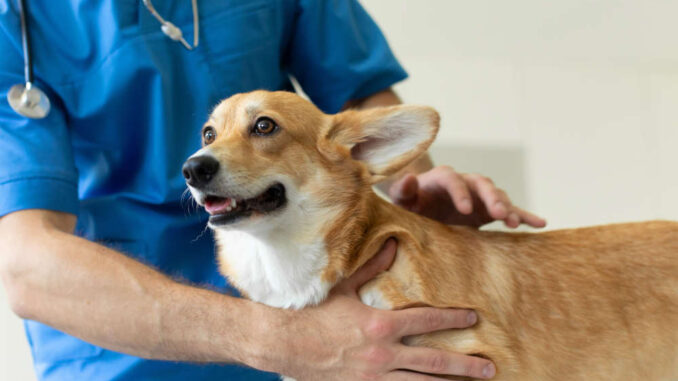
Dog hives definitely carry a certain wow factor in their appearance and sudden onset, even for seasoned veterinarians. Dog owners may be wowed and even a little scared about seeing hives in their dogs. Fortunately, were here to help you identify dog hives and give some tips on how you can help at home as well as when to get to the vet.
What do hives look like in dogs?
Medically speaking, dog hives are a condition called urticaria. They are often the result of an allergic reaction and so can show up on different parts of the body depending on what the allergen is. For example, hives from a contact allergy to a chemical may only be seen on lighter haired parts of the body like the face, ears, lips, and belly because the thicker hair protects the rest of the skin. For an allergen that is eaten or inhaled, you may see hives popping up all over your dog.
Hives typically look like raised, red welts. These welts may range in size from to more than 1 in diameter. There may be many little ones or just a few larger ones, as shown on the image below.

Hives may be easily visible on lighter haired parts of the body and more difficult to see in longer-haired pups. In the longer-haired parts, you may notice small tufts of hair standing up over your dogs back and sides that when you touch them feel like a raised bump.
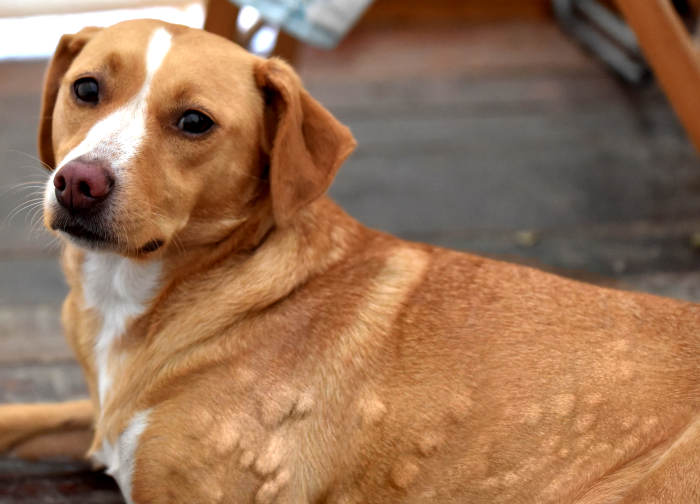
The welts may feel warm to the touch and are usually very itchy.
Dog hives can also cause swelling, especially in the mouth, lips and face.
What causes dog hives?
Dog hives most often come from an allergic reaction to various allergens. These allergens may be something that your dog came in contact in their environment, inhaled or ingested. Some of those include:
- Lawn and cleaning chemicals
- Pollen, mold, dust
- Food-both human and dog
- Medications
- Vaccinations
- Insect bites, stings
Are dog hives an emergency?
Most of the time dog hives show up very quickly and also disappear very quickly. Mild to moderate cases may only last for a few hours, while more severe cases may need veterinary care and take longer to get rid of.
The itchiness that usually accompanies dog hives make your dog uncomfortable but rarely in serious danger. However, if your dog is experiencing hives and swelling of the face, mouth, or nose, there is a possibility that your dogs breathing could be affected. If a pup is having difficulty breathing due to hives or the allergic reaction, seek veterinary care immediately.
5 steps to treat your dogs hives at home [vet recommended]
Since most cases of dog hives arent a serious, immediate concern, you can often start treating them at home first. Of course, if your pup is having swelling of the face or mouth or having issues breathing, or any other signs of illness, get them to a vet as soon as possible. Otherwise:
1. If you happen to know what brought on your dogs hive-great! Remove that allergen right away. The more likely scenario is that you wont know exactly what caused it, and thats ok.
2. If you suspect a contact allergen is to blame, you may start by bathing your pup with a gentle soap to remove as much of the irritant as possible. Youll know to suspect a contact if the hives are more severe on the lighter haired parts of the body or if they just showed up when your pup was around something new.
BURT'S BEES FOR PETS Natural Hypoallergenic...- DID YOU KNOW DOG SKIN DIFFERS FROM HUMAN'S - Dogs' skin is less acidic than human skin, so human shampoos destroy a dog's skin protective barrier, leaving your pet vulnerable to itchy flaking
3. From there, and for other types of allergens, you may apply a cool compress, such as a wet towel, to help quiet the itching and cool the warmness.
MUELLER Sports Medicine Reusable Fabric...- INTENDED USE: A versatile, non-toxic soft gel pack recommended for treatment of minor scrapes and bruises, muscle aches and sprains, headaches and minor burns. That can be to sooth your ankles, knees, shoulder, stomach, legs and more!
4. If you contact your veterinarian, they may advise you to give an antihistamine. Dont do this unless directed by your vet as you want to make sure to give the right product at the right dose.
5. Call your vet if your dog experiences a severe allergic reaction, including hives. You may also want to have a checkup if your dog has shown up with hives more than once in a short time.
How do I know if I need to take my dog to the vet for hives?
Most cases of dog hives are going to pop up, look terrible, feel itchy and then go away, all within the course of a few hours to less than one day. But that doesnt mean that dog hives can be ignored. See your vet immediately if your dog is having any kind of difficulty breathing. This can mean heavy panting, wheezing, trouble getting enough air, or not wanting to exercise.
Youll also want to see your vet if your pup gets heavy swelling of the mouth, nose, or face even if they arent having trouble breathing. This is because the swelling can continue to increase and start to affect the airways.
Another reason to make a veterinary appointment is if your dogs hives dont go away or start to get worse within a couple hours. Contact your vet if youre noticing hives more than once within a short time as it could indicate that your pup needs a change in their diet or medications.
If your dog recovers from hives at-home without any issues, just be sure to mention it to your vet the next time youre there.
Veterinary treatment for dog hives & prognosis
Your vets aim will be to reduce the swelling caused by hives so that your pup can breathe easy. They will also want to cut down on the itching and discomfort.
Treatment
To do this, your vet may give a dog with hives an injection of antihistamines or other anti-inflammatories. Most of the time, this step works like magic to bring quick relief to your dog and your worried mind.
More serious cases may require fluids and other supportive treatments, including hospitalization.
If your dogs hives are a recurrent issue, your vet may recommend allergy testing, an elimination diet, or long-term allergy treatment to get things under control.
Look to spend $50-$100 for simple cases of hives and $200 or more for more severe issues.
Prognosis
Most dogs are going to recover very quickly from hives at home. Those that do go to the vet recover quickly as well after a dose of antihistamines or anti-inflammatories. A very small number of dogs may experience anaphylaxis.
How long before my dogs hives go away?
Most dog hives are going to come and go within a few hours, and sometimes veterinary treatments will handle them within a few minutes. Its all going to depend on the degree of reaction that your dog is experiencing. If youre at all concerned, contact your veterinarian.
FAQ
Can I give my dog Benedryl for hives?
Antihistamines are a great way to help get dog hives under control. However, you dont want to give Benedryl or any other antihistamine without consent from your vet first to make sure your dog is healthy enough for the medication and that you get the right dose.
What if Benedryl isnt working for dog hives?
If your vet advises you to give your dog Benedryl for hives and it doesnt start to show some improvement within a few hours, call your vet. They will more than likely want to see your dog to find out why the medication isnt working.
Are there topical creams that can be safely used to help with dog hives?
Your vet may recommend applying a topical anti-inflammatory or antihistamine to your dogs hives. However, you dont want to put anything on your dog without first talking to your vet.
Can I use natural remedies for dog hives?
Using a topical vitamin E lotion may provide some relief for the itchiness that comes with dog hives, just be sure to talk to your veterinarian first. Bathing with an oatmeal soap may also provide some relief.
Dr. Chyrle Bonk received her Master in Animal Science from the University of Idaho and her Doctorate of Veterinary Medicine (DVM) from Oregon State University in 2010. She has over 10 years of experience in small animal veterinary practice, working for a veterinary clinic in Idaho.
View all posts
Disclaimer: This website's content is not a substitute for veterinary care. Always consult with your veterinarian for healthcare decisions. Read More.


